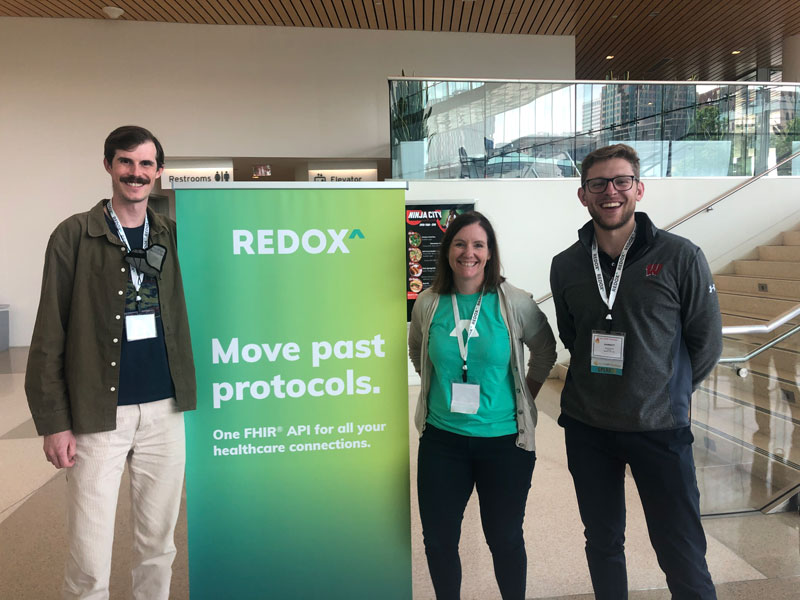HL7® FHIR® DevDays top 5 takeaways
Jun 28, 2022

Redox had an incredible time as a Gold Sponsor at 2022 HL7® FHIR® DevDays earlier this month. DevDays is the #1 event for FHIR developers around the world. After two long years of virtual-only interaction, it was amazing to be back in person. No matter how hard you try, you really cannot replicate it.
We are already looking forward to next year. If you have never been, here are our top 5 takeaways that might nudge you toward making the trip next year (not including the fact that there are always stroopwafels on the menu, and it might be in Amsterdam next year).
FHIR is lighting up. While progress may seem slow at times, DevDays affirmed that the pace of FHIR adoption is gaining momentum. In-person and virtual attendees joined from all over the globe, representing some of the most innovative organizations across the healthcare landscape. This included both Google Cloud and Microsoft as Platinum sponsors. These giants are entrenched in the infrastructure of most healthcare institutions worldwide. As they lean hard into this community it seems clear that the speed of FHIR adoption is likely to go into overdrive in the coming years. Both companies hosted several well-attended sessions. We were particularly captivated by Vivian Neilly (Girl on FHIR) from Google's session on building standardization for representing artificial intelligence (AI) outputs in FHIR responsibly. We loved the forward-thinking discussion on how AI inputs can be represented, explained, and actioned by various users (data scientists, clinicians, and patients), getting ahead of creating positive experiences as both FHIR and AI become ubiquitous.
There is still much to do. We genuinely appreciate the acknowledgment that this work is not always easy. Grahame Grieve (the true FHIR starter) led sessions where he addressed ambiguity head-on. Grahame gave his take on how to deal with multiple implementation guides, and whether or not data should be stored as FHIR resources. In both cases, there are certainly “better” answers, but there are no truly “right” answers. While 100% clarity would always be ideal, we are excited to be a part of unraveling these and other questions with the HL7 FHIR community in the years ahead.
Much of FHIR’s future relies on legislation. There are few industries where technology and legislation are so tightly interwoven, and so it is no surprise that getting updates on the technical advances of FHIR comes with a healthy side dish of updates on relevant legislation. We loved the FHIR Roadmap for TEFCA Exchange session as Christopher Muir from ONC and David Pyke from the Sequoia Project gave updates on where we are at, what we know, and the (many) unknowns of TEFCA. While there is still a fair amount of uncertainty, we remain certain that the Redox FHIR® platform is ready to support the draft FHIR framework for TEFCA and we will help our customers connect to any and all identified Qualified Health Information Networks (QHINs) on the first day of the first QHIN go-live.
FHIR WILL lead to a fix for prior authorization. Speaking of legislation, DevDays featured not 1, not 2, but 3 sessions on prior authorization, including “X12 gets Lit” by our very own Garrett Rhodes (check out the recording below). All the prior authorization sessions showcased a great deal of advancement as relevant DaVinci implementation guides are being used in the real world, but also reminded us that the finish line is not quite in sight. CMS has a temporary exception in place that removes the need to use X12 by payers, but varying adoption of the needed FHIR resources, previously mandated use of X12 by payers, and varying adoption of X12 by providers leaves us with more questions than answers for now. What we do know is that the current framework leaves room for Redox’s X12 to FHIR product to help bridge the gap between standards for prior authorization.
You can (and should) start using FHIR today. Despite a fair amount of ambiguity and uncertainty with FHIR, the Redox FHIR API can help you start using the standard today, without any sacrifice. Gino Canessa from Microsoft covered using topic-based subscriptions, for which there is only a draft resource and unpublished (but highly anticipated!) Implementation Guide. This is exciting as it will simplify the monitoring of events (e.g. patient admission) using the FHIR protocol. This being said, we predict it will likely take EHR FHIR APIs some time to adopt this new capability (if they do it at all). The good news is that if you want to use FHIR, you don’t have to wait. Redox FHIR can provide this type of event-notification functionality today. We take event-based HL7v2 and transform it into FHIR.
See you next year (hopefully) in Amsterdam?! The stroopwafels are going to be off the [CDS] hook (too much?)!
FHIR® is a registered trademark of Health Level Seven International (HL7) and is used with the permission of HL7. Use of this trademark does not constitute an endorsement of products/services by HL7®.
